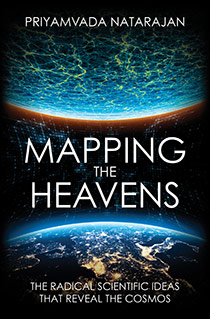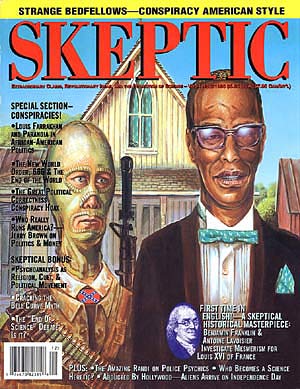In this week’s eSkeptic:

About Science Salon
In the tradition of the Enlightenment salons that helped drive the Age of Reason and the public interest in science, the Skeptics Society is pleased to announce the next two intimate Science Salons featuring an “in conversation” between Dr. Michael Shermer and professor of cognitive science, Dr. Benjamin Bergen (October 16) and cosmologist and theoretical astrophysicist, Dr. Priyamvada Natarajan (November 13). Dr. Shermer will discuss the guest’s latest science book or research project in a dialogue format, followed by an intimate conversation with the audience that allows more interaction with the guest than a formal Q&A.
IMPORTANT TICKET INFORMATION: Advance tickets are required. Tickets will not be sold at the door. Purchase by calling the Skeptics Society office at 1-626-794-3119. Seating is limited. $50 per individual (includes a reserved seat, autographed copy of the guest’s book, hors d’oeuvres and wine).
WHAT THE F
What Swearing Reveals About Our Language, Our Brains, and Ourselves
Dr. Benjamin Bergen is a professor of cognitive science at the University of California, San Diego, and in his new book he explains why profanity is so appealing to us. Let’s face it, we all swear. Whether we’re happy or mad, uttering a four-letter word seems to be a natural occurrence for most of us. But why do we swear, even when we know we’re breaking cultural taboos? Why are some words off limits in certain countries or deemed offensive in past centuries but are considered perfectly tame in others? What does all this g*ddamn swearing tell us about our language and our brains? Bergen has the answers as he illuminates the controversial and complex nature of profanity and its relationship on our culture.
Order What the F: What Swearing Reveals About Our Language, Our Brains, and Ourselves from Amazon.
Call 1-626-794-3119 now to reserve.
MAPPING THE HEAVENS
The Radical Scientific Ideas That Reveal The Cosmos
Dr. Priyamvada Natarajan is a cosmologist and theoretical astrophysicist from Yale University, specializing in dark matter, dark energy, and black holes. She also holds the Sophie and Tycho Brahe Professorship of the Dark Cosmology Centre, Niels Bohr Institute, at the University of Copenhagen, Denmark. She is passionate about sharing science with the general public and in her new book she provides a tour of the “greatest hits” of cosmological discoveries—the ideas that reshaped our universe over the past century. The cosmos, once understood as a stagnant place, filled with the ordinary, is now a universe that is expanding at an accelerating pace, propelled by dark energy and structured by dark matter. Priyamvada Natarajan is at the forefront of this research—an astrophysicist who literally creates maps of invisible matter in the universe. In the book, she not only explains for a wide audience the science behind these essential ideas but also provides an understanding of how radical scientific theories gain acceptance. The formation and growth of black holes, dark matter halos, the accelerating expansion of the universe, the echo of the big bang, the discovery of exoplanets, and the possibility of other universes—these are some of the puzzling cosmological topics of the early twenty-first century. Natarajan discusses why the acceptance of new ideas about the universe and our place in it has never been linear and always contested even within the scientific community. And she affirms that, shifting and incomplete as science always must be, it offers the best path we have toward making sense of our wondrous, mysterious universe.
Order Mapping the Heavens: The Radical Scientific Ideas That Reveal The Cosmos from Amazon.
Call 1-626-794-3119 now to reserve.
The Best Laid Plans
MONSTERTALK EPISODE 111
In this episode of MonsterTalk, Karen and Blake thank listeners for their amazing support, and discuss upcoming episodes in the works.
Get the MonsterTalk Podcast App and enjoy the science show about monsters on your handheld devices! Available for iOS, Android, and Windows 8 devices. Subscribe to MonsterTalk for free on iTunes. Follow the RSS feed.
![A graph of a chaotic function called the Lorenz attractor, by User:Wikimol, User:Dschwen [GFDL, CC-BY-SA-3.0, via Wikimedia Commons (https://simple.wikipedia.org/wiki/Chaos_theory#/media/File:Lorenz_attractor_yb.svg), and Blue Morpho butterfly (https://www.pexels.com/photo/blue-brown-white-black-66877/) [CC0 1.0]](https://www.skeptic.com/eskeptic/2016/images/16-08-31/Lorenz-attractor-buttefly.jpg)
A graph of a chaotic function called the Lorenz attractor, by User:Wikimol, User:Dschwen [GFDL, CC-BY-SA-3.0, via Wikimedia Commons, and Blue Morpho butterfly [CC0 1.0]. The Lorenz attractor is a set of chaotic solutions of the Lorenz system which, when plotted, resemble a butterfly. The term “butterfly effect” was coined by Edward Lorenz.
In this week’s eSkeptic, Bernard Leikind reminds us how fortunate we are to stand grounded on a foundation of scientific knowledge in the face of uncertainty.
Bernard Leinkind’s column, “The Question All Skeptics Are Asking,” appeared in Skeptic magazine 4.3 (1996). Read Leikind’s bio at the end of this article.
What Will Tomorrow Bring?
by Bernard Leikind
A great plane falls from the sky and takes 230 lives. The newspapers fill with stories of fate’s quirks. Thunderstorms kept another plane on the ground for four hours in Chicago. One of its passengers had a ticket on the doomed plane, which she missed by a few minutes. “Thank God,” she told a reporter. An unfortunate young man arranged to fly a package to Europe as a courier. He planned to visit his sweetheart in London. Joyful at his free ticket and filled with delicious anticipation, he met his death. What does it mean that destiny chose one to survive and the other to die?
Television and the press fill with stories responding to our fascination and horror at life’s uncertainties. What made TWA Flight 800 a target? Why did fate draw these particular people to their common destiny? Literature, great and otherwise, often treats of fate’s powers. The ancients believed that fate worked upon human character to produce inevitable tragedy. Thus honorable Oedipus seeks the truth to save his city and discovers the awful facts of parricide and incest. We moderns are more likely to think that fate strikes us random blows. In The Bridge of San Luis Rey, Thornton Wilder sought the common threads that placed certain people on a collapsing bridge. In Kurt Vonnegut’s novels, fate is a prankster, while John Barth’s novels portray predestined malevolence.
For some centuries the progress of modern science has created the feeling that we, at last, were gaining some control over the unpredictable forces of nature. Ancient scourges, such as smallpox, are gone. The water is safe to drink. We have been secure from war on our soil, and we survive even natural disasters. Even so, many of us believe that our parents and grandparents led safer lives, and we fear that the future will only bring deterioration and danger.
Just as we must know what we are looking at to see it, so we must have the proper language to think about the natural world.
Until recently science, at least, had the reputation for unceasingly improving our ability to anticipate and mold the future. Now scientific discoveries themselves seem to undermine science’s credibility. Chaos theory, sensitive dependence on initial conditions, bizarre strange attractors, and the notorious butterfly effect afflict us. Scientists tell us that the tiniest disturbances in nature lead to wildly unpredictable outcomes. The foundations of physics, the most certain of all the sciences, settle in the liquefied soil of nonlinear systems.
A California butterfly flutters this way instead of that. A tiny parcel of unstable air bubbles skyward. But for the butterfly it would have stayed in its place. Soon a cloud appears. Beneath the cloud the ground cools in the shade while the southwestern sun sizzles the rest. Large swirls of warm air lift soaring birds and draw cooler air from the nearby sea. Each effect is the predictable consequence of its cause, but the result changes the weather sweeping eastward around the globe. As the unpredictable consequence, a great storm douses Rangoon. Are the world’s workings a Newtonian clock or a Rube Goldberg machine? […]
BACK TO SCHOOL
Donate to Skeptic by Shopping at Amazon!
Shop at Amazon in support of your Skeptics Society when you shop for back-to-school items (or any time, actually). The Skeptics Society will receive a small commission on your purchases. Thank you!



















